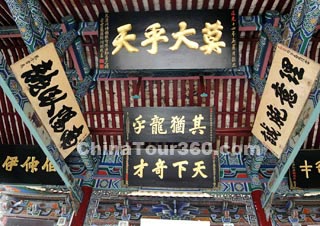Thousand years of history has left China precious treasure of art. Traditional Chinese arts are expressed in the forms of painting, calligraphy, music, dancing, opera, gardening, sculpture and traditional dressings.
![]() Painting is an art which is done using a brush on paper or silk, often with black ink alone. It is a monochromatic work derived, perhaps, from calligraphy. A painting is a distinctive object based on centuries-old traditions common to many things in China.
Painting is an art which is done using a brush on paper or silk, often with black ink alone. It is a monochromatic work derived, perhaps, from calligraphy. A painting is a distinctive object based on centuries-old traditions common to many things in China.
 |
| Chinese Calligraphy |
![]() Calligraphy, literally 'beautiful writing', is one of the traditional four arts dating back to the earliest days in China. Calligraphy, the ancient written word, is not just a method of communication but also a means of expressing the dynamic forces of the natural world.
Calligraphy, literally 'beautiful writing', is one of the traditional four arts dating back to the earliest days in China. Calligraphy, the ancient written word, is not just a method of communication but also a means of expressing the dynamic forces of the natural world.
![]() Music: The body of vocal and instrumental music composed and played by the Chinese people has a history of more than 8,000 years. It has a very early development of theoretical, systematic, acoustical, and material science, and orchestral practice.
Music: The body of vocal and instrumental music composed and played by the Chinese people has a history of more than 8,000 years. It has a very early development of theoretical, systematic, acoustical, and material science, and orchestral practice.
![]() Opera is a traditional form of stage entertainment, weaving together elements of mime, dance, song, dialogue, swordplay, and acrobatics into one fluid continuous flow. Gestures, movements and expressions incorporated within each performer's script come together to bring forth an impressive performance. In contrast to Western stage entertainment, which is subdivided into different categories such as opera, drama and sketches, it has remained faithful to its original format over the centuries.
Opera is a traditional form of stage entertainment, weaving together elements of mime, dance, song, dialogue, swordplay, and acrobatics into one fluid continuous flow. Gestures, movements and expressions incorporated within each performer's script come together to bring forth an impressive performance. In contrast to Western stage entertainment, which is subdivided into different categories such as opera, drama and sketches, it has remained faithful to its original format over the centuries.
Dancing is the oldest art of mankind. The earliest dancing in China was usually a way to express feelings or describe daily life of the people in primitive times. Later in the Xia and Shang dynasties, dancing became a part of the exorcism or sacrifice ceremonies. During the Eastern Zhou Dynasty, professional dancers and dancing for performance appeared. There are many famous dancers in ancient China, such Madam Qi and Zhao Feiyan of the Han Dynasty and Yang Yuhuan of the Tang Dynasty.
As one of the three components of world gardening system, Chinese gardening has a history of over 3,000 years; the other two being the European gardening and Western Asian gardening. Gardens in China, according to location, can be divided into gardens of the southern Yangtze River, the Pearl River delta, the Sichuan areas and northern China areas. The gardens of China can also be divided into imperial gardens, that for man of letters, temple gardens and landscape gardens.
Sculpture is also an important part of traditional arts of China. The statuettes on roofs in the Ancestral Temple of Chen’s Family in Guangzhou, the exquisite carved wooden furniture exhibited in Shanghai Museum and the lively stone carvings in Maogao Grottoes represent the best but various styles of sculptures.
Traditional Chinese dressing of different times reflects distinct features of the period. The cheongsam is derived from the traditional dress of the Manchu of the Qing Dynasty, but becomes less conserved than the old dress.







